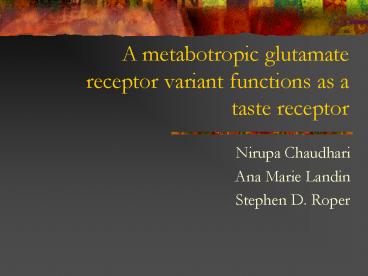A metabotropic glutamate receptor variant functions as a taste receptor - PowerPoint PPT Presentation
1 / 18
Title:
A metabotropic glutamate receptor variant functions as a taste receptor
Description:
Melanie Zeck, Presenter. November 29, 2004. The Tongue: What ... b) Use PCR to identify the relationship between the receptor in the tongue and in the brain. ... – PowerPoint PPT presentation
Number of Views:87
Avg rating:3.0/5.0
Title: A metabotropic glutamate receptor variant functions as a taste receptor
1
A metabotropic glutamate receptor variant
functions as a taste receptor
- Nirupa Chaudhari
- Ana Marie Landin
- Stephen D. Roper
2
Sensation and Perception
- Melanie Zeck, Presenter
- November 29, 2004
3
The TongueWhat you were taught
4
The New Tongue
5
Question
- General Is there really a fifth taste receptor?
- Specific What is it and what is it sensitive
for?
6
Alternatives
- No, there are only four
- Sweet
- Sour
- Salty
- Bitter
- Yes, there are five
- UMAMI
- Something else
7
Logic
- If evidence is discovered that a receptor in the
tongue has the same response properties as would
be expected from response curves to that stimulus
psychophysically, this suggests that this
receptor is a receptor for that stimulus. - If such a receptor for Umami-responses can be
found, then it can be concluded that a fifth
receptor exists and that it senses Umami.
8
Methods
- Subjects Harlan Sprague-Dawley rats
- a) Clone the glutamate receptor in the tongue of
the rats - b) Use PCR to identify the relationship between
the receptor in the tongue and in the brain. - c) Compare functional properties of tongue
receptor with brain receptor (Response to
Umami/Glutamate) - d) Compare functional properties of tongue
receptor with brain receptor to another substance
that tastes like Umami
9
Results
- The cloned mGluR4 receptor in the tongue is
similar to the mGluR4 receptor in the brain. - It is only expressed in taste buds.
- It is structurally similar but truncated.
- In particular, the Glutamate binding region is
very short in the tongue-version (taste-mGluR4).
10
Results
Structure
Model
PCR
Assay
11
Results
- Taste-mGluR4 is much less sensitive to Glutamate
than brain-mGluR4, as would be expected by the
concentrations encountered by a taste receptor. - Brain-mGluR4 is sensitive to the Neurotransmitter
Glutamate in minute, microMolar concentrations.
(2 µM brain vs. 280 µM taste)
12
Results
- Taste-mGluR4 reacts the same way (reduction in
cAMP expression) to L-AP4 (that tastes like
Glutamate) as it does to L-MSG. - Again, brain-mGluR4 is much too sensitive to
L-AP4 to be an effective taste-receptor.
13
Results - Summary
- A truncated version of mGluR4 in the brain that
is sensitive to the Neurotransmitter Glutamate
could be cloned in the tongue. - It is only expressed in taste buds.
- Like the brain receptor, it is sensitive to
L-MSG, but only if the concentration of L-MSG is
much higher, as is adequate for signaling the
presence of a substance on the tongue, as opposed
to signaling the presence of a neurotransmitter. - As would be expected if it is a Glutamate
receptor, the response to L-AP4 (which tastes
like Glutamate) is similar to the response to MSG
directly.
14
Interpretation
- The four-receptor model of the tongue no longer
applies. - There is at least one other basic taste receptor
in the tongue, which is sensitive for MSG. - This receptor seems to be taste-mGluR4.
15
Problems
- All these results are only CONSISTENT with the
notion that taste-mGluR4 is a taste receptor for
Umami, but they do not prove the receptors
existence. - How to prove that the receptor exists?
16
The Proof
- a) Recording from taste-mGluR4 receptor in the
tongue, predicting behavioral response of an
animal trained to select Umami-tagged stimulus. - b) Create a knock-out rat that has no such
receptor and show that it is unable to taste
Umami.
17
Comments
- Brain-receptors are sensitive to monosodium
glutamate in very small amounts. - Tongue receptors are sensitive to only large
amounts of glutamate. - It looks like the organism retained a mutated
version of an already developed receptor for
another function (!)
18
Comments, continued
- This discovery also indicates
- many more discoveries are possible in the
areas of sensation and perception other
than vision science.































